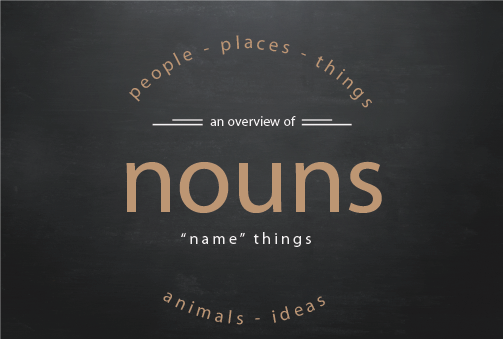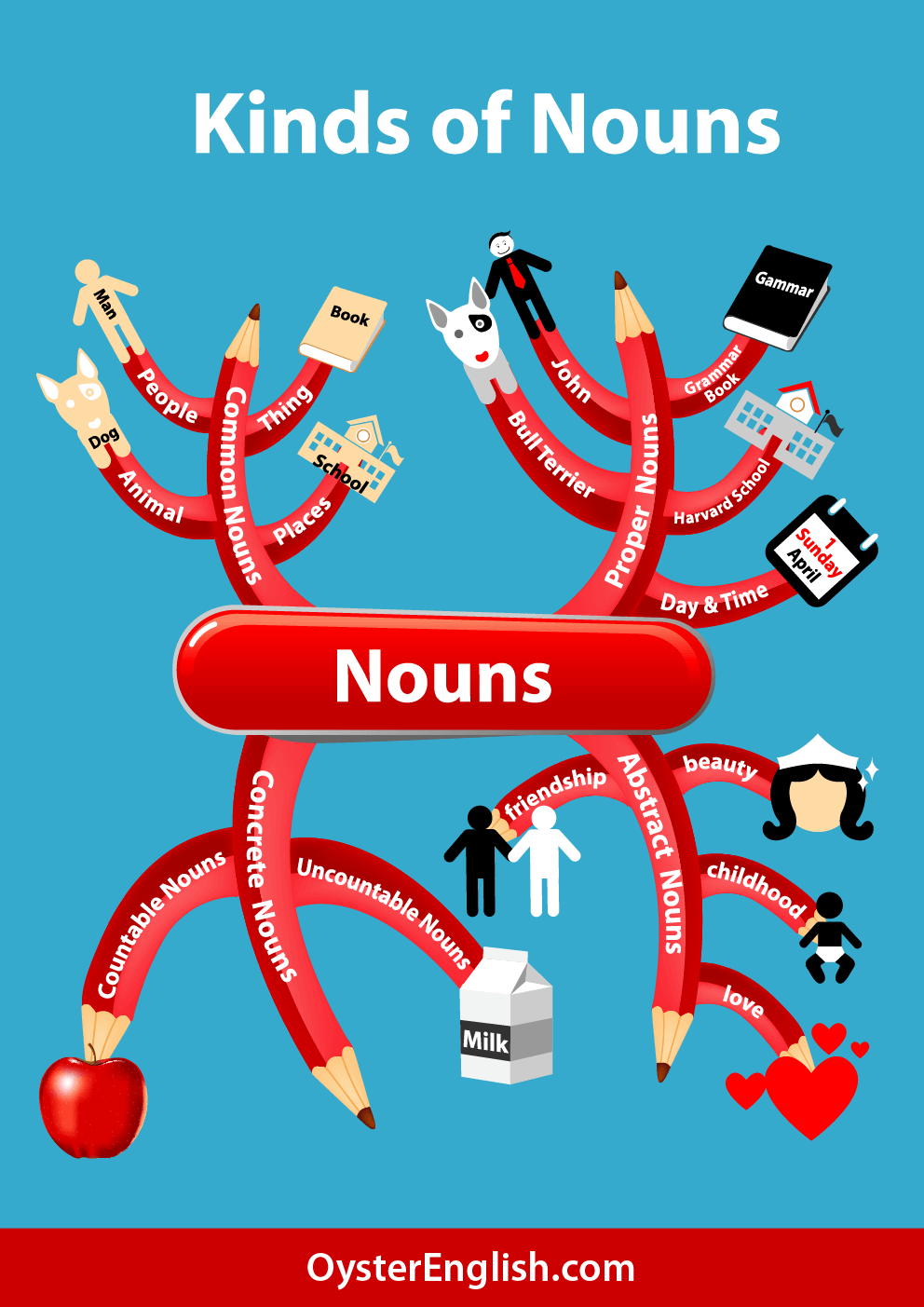All About Nouns

Let’s learn about nouns and how to use them correctly with fun exercises.
First, we'll cover the different types including countable, uncountable, common, proper, abstract, concrete, collective, possessive, singular and plural. We'll also look at some of their different functions in sentences (subjects, direct objects, indirect objects, objects of prepositions).
First things first:
A noun is a word which names a person, place, thing, animal or idea.
Here are a few examples:
- Joseph, grandmother, teacher (people)
- restaurant, France, beach (places)
- book, ball, pizza (things)
- cat, lion, fish (animals)
- philosophy, love, happiness (ideas)
Types of Nouns
* Important * - A noun will fit into several of these categories, not just one. [e.g., book is a common, concrete, countable, singular noun]
Common & Proper Nouns
All nouns are either common or proper.
Common nouns name general (not specific) people, places, things, animals or ideas.
- For example: teacher, scientist, library, kitchen, table, phone, happiness, love, freedom.
Proper nouns name specific people, places, things and ideas. In English, proper nouns are normally CAPITALIZED.
|
Proper Noun Type Names of people Titles Institutions Buildings & Structures Places Religious names Historical names Events & Festivals Months / Days of the Week |
Example Madonna, Mr. Jones Mr, Mrs, Professor, Dr., Sir United Nations, Coca-Cola, Louvre Museum The White House, Golden Gate Bridge Europe, London, Antarctica, Sahara Desert Hinduism, Koran, Bible, Buddhism World War II, Ottoman Empire, Dayton Accords Olympic Games, Boston Marathon, New Year's Eve January, August, Tuesday, Saturday |
Remember that common nouns name general things and proper nouns name specific things:
|
Common Noun teacher country holiday day university |
Proper Noun Professor Jones Canada Ramadan Tuesday Harvard University |
Abstract & Concrete Nouns
Abstract nouns name something you cannot see or touch. They're harder to define and name things that are related to ideas, feelings and time.
- For example: bravery, friendship, culture, sadness, morning, health
Concrete nouns name things that you can physically touch or see.
- For example: Uncle Charlie, telephone, automobile, elephant
Countable & Uncountable Nouns
All common nouns can either be counted with numbers or they cannot be counted.
Countable nouns can be easily counted.
- You could count the number of apples in a basket (e.g., 5 apples) or the number of desks in a classroom (e.g., 20 desks).
- Examples of countable nouns: tomato, computer, finger, house, elephant
Uncountable nouns are difficult to count or divide into separate parts because they:
- are the name for abstract ideas and concepts: love, sadness, safety, freedom, power
- are tiny objects: powder, sand, rice
- don't have a clear form like liquids or gases: water, coffee, milk, air, oxygen
- are categories of things: furniture, music, luggage
To make things a little complicated, some nouns can be both countable or uncountable. It depends on the meaning you are trying to convey. For example:
|
Uncountable (conveys a general meaning) You look good with long hair. (general meaning - all the hair on your head) |
Countable (conveys a specific meaning) The police found two hairs at the crime scene. |
|
My skin is very dry. |
The purse is made of several snake skins. |
|
Do you recycle paper? |
I left some papers on the printer. |
Click here for more information about countable and uncountable nouns.
Singular & Plural Nouns
Singular nouns name just one (single) thing.
- Example: blueberry, democracy, relationship, one cat, a sofa
Plural nouns name more than one thing.
- Example: blueberries, democracies, relationships, two cats, sofas
There are regular and irregular plural nouns. Most nouns have a distinct (different) singular and plural form, however some nouns do not have a plural form.
Since there are several different rules and exceptions, for more information about plural nouns click here. (I've included lots of examples on the linked page.)
Collective Nouns
Collective nouns are made of more than one word which describe a group of people or things as one unit. Think of it as a collection of things together.
- For example: a herd of elephants, a crowd of people, a bunch of flowers.
- Other examples: family, team, majority, nation, class, choir, jury, fleet, cabinet (of ministers)
Compound Nouns
Compound nouns are made up of two or more words.
- Examples: backspace, blackboard, copyright, daylight, downstairs, earring , everything , haircut, handwriting, toothpaste, weekend, lipstick, keyboard
Possessive Nouns
Possessive nouns show ownership or possession (something belongs to the noun). For example:
- Sandra's shoes. (the shoes belong to Sandra)
- The boy's bicycle. (the boy owns the bicycle)
- The student's intelligence. (the student possesses intelligence)
To make a singular noun a possessive noun, add an apostrophe ( ' ) plus an -s:
|
Singular Noun Joe boy sofa |
Possessive Noun Joe's sweater boy's book sofa's cushions |
To make a plural noun a possessive noun you must look at the last letter of the word:
- Normally, add an apostrophe ( ' ) and -s
- However, If the noun ends in -s add an apostrophe ( ' ) after the -s.
|
boys women students |
boys' toys women's rights students' teacher |
Noun Functions
It is good to know a little bit about how nouns can be used in sentences. Nouns are one of the eight parts of speech in English and in any sentence they can do different jobs. Nouns can be:
Subjects: A noun can be the subject of a sentence or clause, describing whom or what the sentence is about.
- Examples: Pizza is delicious. The boy ran through the park.
Predicate nominative: A noun can rename the subject by completing a linking verb.
- Example: Jessica is my best friend. (Answers the question who is Jessica?)
Direct objects: A noun can receive the action of a verb.
- Example: I threw the football.
Indirect objects: Nouns can receive the direct object.
- Example: I threw John the football.
Object of the preposition: In a prepositional phrase, a noun can follow a preposition and complete its meaning.
- I threw the football to John.
Object complement: here a noun directly follows and describes the direct object.
- Our coach named me team captain.
- Home Page ›
- Main Grammar Page ›
- Parts of Speech ›
- Nouns

